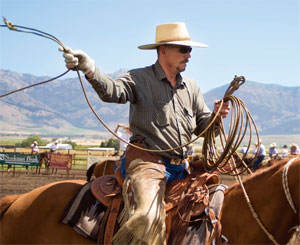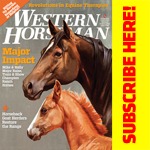This Montana-based organization brings together working cowboys and weekend ropers in friendly competitions, while celebrating the ways of the early California vaquero.
By Guy de Galard
It is almost dark by the time I reach Bozeman, Montana. While reading the directions I had scribbled on a small piece of paper, I navigate through an upscale neighborhood on the edge of town. After one last turn, I try to read the street numbers in the dim light. Looking ahead, I see dark silhouettes in cowboy hats roping a dummy right in the middle of the street.
Paul Woods and his girlfriend, Cid Klebenow, greet me and introduce me to the rest of the ropers. All of us will spend the night at Paul’s house to be ready bright and early for the next day’s ranch-roping competition, held in nearby Belgrade.
A heavy rain the previous afternoon has Woods concerned about weather conditions for the roping, but we wake up to a glorious day. By 8 a.m., the Circle L Arena, located at the foot of the scenic Bridger Mountains, is bustling with activity. Trailers pull in and horses are unloaded while a continuous flow of riders head for the barn, where a tasty breakfast is served.
“We’re lucky because this place is the only one in the Gallatin Valley that can provide both the arena and the cattle,” Woods says. “It’s also centrally located for a lot of guys from Montana, Idaho and Wyoming.”
IN THE EARLY 1990S, California cowboy and clinician Joe Wolter began conducting ranch-roping clinics in Montana. He taught a variety of elaborate loops, many influenced by the Spanish vaqueros for whom style and finesse mattered more than speed. Wolter’s skill caught the Big Sky cowboys’ attention and sparked regional interest in vaquero-style roping, with its emphasis on horsemanship, safe stock-handling and versatile loops.
“This style of roping was a new concept here 10 years ago,” recalls Marc Brogger, a cowboy who attended one of Wolter’s early clinics. This led to a 1998 ranch-roping competition in Red Lodge, Montana. Organized by Brogger and judged by Wolter, the event was a timed, three-man calf-doctoring contest with bonus points for fancy loops. Later that fall, another contest was held in Three Forks, Montana.
Early in 1999, Northern Range Ranch Roping Series was born, with seven timed contests that year. The Carriage House Ranch in Big Timber, Montana, was the site of the first NRRRS Finals. Since 2000, the finals have been held at the Northern International Livestock Exhibition in Billings, Montana.
NRRRS shifted from timed events to judged contests, where points are earned for proper cattle handling, difficult catches and fancy loops.
“We wanted to encourage contestants to throw fancy loops,” Brogger explains, “without discouraging the ones who had never tried them.”
NRRRS HAS UNDERGONE some changes through the years, but the format—a big square pen with 10 head of cattle inside—has remained the same. Contestants are divided into three-man teams, simulating the small working crews on most buckaroo outfits.
“The event came off a working cattle operation,” explains George Kahrl, who provided the cattle for the first ranch-roping competition. “There is a lot of horsemanship involved in ranch roping, which means having my horse do exactly what I want, so that the cow will do exactly what I want.”
Typically, NRRRS holds 13 to 17 ropings each summer, in addition to a winter series held in Sheridan, Wyoming. Interest for this style of roping continues to grow.
“We experienced 100 percent growth in 2007 and NRRRS rules are used for other ranch-roping venues, as far away as South Africa,” says Scott Grosskopf, NRRRS president. “I see the sport growing to a point where there’ll be a world championship for ranch roping.”
NRRRS awards custom saddles to high-point ropers. Other prizes include wool saddle blankets, silver conchos, and rawhide reins and romals.
 RANCH ROPINGS AREN’T RE-STRICTED to working cowboys. They are a gathering of young and old, novice and pro.
RANCH ROPINGS AREN’T RE-STRICTED to working cowboys. They are a gathering of young and old, novice and pro.
“The novice division is what makes this sport work,” says Grosskopf. “It’s a great way to get started before you get thrown to the wolves in the open division.”
Until two and a half years ago, Erika Madrigal had never roped. She started taking lessons from fellow roper Ed Disney, and from her husband, Salvador, a skilled roper who grew up in Guadalajara, Mexico.
“I always wanted to rope and I love how this style of roping is easy on the animals,” she says.
Tim Wylder, an attorney from Great Falls, Montana, had roped occasionally at brandings before attending a ranch-roping clinic three years ago.
“I was riding a Tennessee Walker at the time, so the fact that ranch roping was done at a walk or a trot appealed to me,” he says. “I just wanted to rope calves better.” Wylder competed for the first time a year ago and eventually purchased a Quarter Horse, whose disposition was better suited for roping cattle.
To encourage beginning ropers, NRRRS allows novices to partner with more experienced open-division ropers.
“Everyone is very supportive and helpful,” Wylder says. “There is no pressure to make you feel like you have to be a great roper. Everyone is very encouraging.”
FOLLOWING THE NATIONAL AN-THEM, Paul Woods reads the rules to the ropers. NRRRS secretary and announcer Dawn Shyrock gives the running order for 55 teams registered that day. There is no annual membership fee for NRRRS. Instead, there is a $25 entry fee and a $10 per run roping fee.
Once the judges are ready, the first team of three cowboys enters the arena. Each roper must head in one of the three rounds. A rodear of 10 critters is held at one end of the arena. Ranch roping might not be a timed event, but competitions do pit ropers against the clock. Once the announcer designates the number of the critter to rope, the header has two minutes to make his catch. Once the cow is headed, the second roper throws a heel shot. The third rider then throws his rope on the ground, dismounts, lays the cow down, and moves the head loop to the front legs. The header and heeler then “stretch out” the cow. A run must be completed in no more than four minutes. Before time can be called, loops must be clean, without twists or figure eights, both ropes must be tight, and the ground man must be off the cow.
Points are based on the distance and difficulty of the throw, with points added for roping within the rodear line and completing the run in less than two minutes. Penalties are assessed for losing a rope or improper cattle handling, such as dallying on one hind hock. Loping, dismounting without first throwing the rope on the ground, and rimfiring (letting a rope wrap around the header’s horse) cause disqualification.
While the action unfolds in the roping arena, other contestants practice their shots on a dummy in an adjacent pen. Houlihans, hip shots, backhands, Johnny Blockers and del vientos soar into the air before gracefully draping over a wooden dummy. As ropers’ skills have improved, the repertoire of shots on display at NRRRS events has grown.
“A houlihan used to be considered a fancy loop,” Grosskopf says. “Now it’s considered a basic shot.”
Other cowboys watch the action from horseback, praising good throws and encouraging contestants’ efforts to get their jobs done in the arena.
Each competition is also a display of elegant trappings—finely braided bosals, romals and mecates, engraved silver bits and carved saddles. Here, as in the vaquero tradition, artistry and efficiency go hand in hand.
“People take as much pride in their horses as they do in their roping skills,” Woods says.
Growing up on a ranch near White Sulphur Springs, Montana, Woods developed an early interest in the vaquero style through Charles Russell paintings depicting California cowboys’ gear and clothes.
“I wanted to understand more about their skills,” he says. Several years ago, Woods ran 1,800 mother cows and 900 steers by himself before working three summers at the Padlock Ranch, including two on the wagon. Woods doesn’t cowboy for a living these days, but ranch ropings allow him to continue to enjoy the lifestyle and camaraderie.
“Ranch roping is a practical art form that combines good horsemanship, stockmanship and roping,” he says. “It brings together cowboys, ex-cowboys and non-cowboys who all share an appreciation for fine horses and good roping skills. For the ones who don’t cowboy for a living, this is the closest thing to being a cowboy. It’s a good way to keep the tradition alive.”
The organization promotes vaquero ways, but is open to anyone who wants to rope, regardless of their gear and attire. For instance, NRRRS allows rubber on saddle horns.
“We don’t want to discriminate against anyone,” Woods says. “It’s not the gear that makes the hand.”
Guy de Galard is a Wyoming-based writer. The 2008 NRRRS Finals will be held October 11-12 at the NILE show in Billings, Montana. For more information, visit ranchroping.com. Send comments on this story to [email protected].




